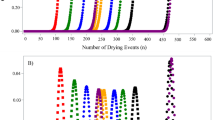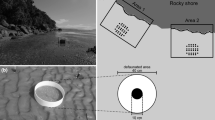Abstract
Soft-sediment recruitment dynamics are dependent upon two sources of colonists; larvae transported from the water column and post-settlement movement of juvenile and/or adult life-stages across the seabed. Differences in the relative dispersal ability of the different life-stages into disturbed patches of habitat should vary predictably with the spatial scale of the disturbance. Smaller patches with a greater edge:surface area ratio should be more influenced by the post-settlement colonist pool than larger patches possessing a smaller edge:surface area ratio. A life stage-based recolonization model, using a Polydora cornuta life table, has been developed to describe how differences in the immigration rates of larvae, juveniles and adults can influence within-patch recovery times. Model results indicate that immigration of adult stages into disturbed patches has the least influence on patch recovery time. In contrast, post-settlement juvenile stages generally has a pronounced effect on patch population dynamics. Experimental evidence of scale-dependent migration of different life-stages to disturbed patches is also presented for the spionid polychaete Boccardia syrtis. Future research on scale-dependent recolonization dynamics in soft-sediment habitats should focus on acquisition of within-patch demographic data in order to more fully understand the importance of post-settlement life-stage movement in regulating population and community dynamics.
Similar content being viewed by others
References
Bonsdorff, E., 1980. Macrobenthic recolonization of a dredged brackish water bay in S.W. Finland. Ophelia (suppl.) 1: 145–155.
Commito, J. A., S. F. Thrush, R. D. Pridmore, J. E. Hewitt & V. J. Cummings, 1995. Dispersal dynamics in a wind driven benthic system. Limnol. Oceanogr. 40: 1513–1518.
Cummings, V. J., R. D. Pridmore, S. F. Thrush & S. F. Thrush, 1995. Post-settlement movement by intertidal benthic macroinvertebrates: Do common New Zealand species drift in the water column? New Zealand J. mar. Freshwat. Res. 29: 59–67.
Dayton, P. K. & J. S. Oliver, 1980. An evaluation of experimental analysis of population and community patterns in marine environments. In K. R. Tenore & B. C. Coull (eds), Marine Benthic Dynamics. University of South Carolina Press, (SC): 93–120.
Emerson, C. W. & J. Grant, 1992. The control of soft-shell clam (Mya arenaria) recruitment on intertidal sandflats by bedload sediment transport. Limnol. Oceanogr. 36: 1288–1300.
Gascon, C. & J. Travis, 1992. Does the spatial scale of experimentation matter? A test with tadpoles and dragonflies. Ecology 73: 2237–2243.
Grassle, J. F. & J. P. Grassle, 1974. Opportunistic life histories and genetic systems in marine benthic polychaetes. J. mar. Res. 32: 253–284.
Gunther, C. 1992. Dispersal of intertidal invertebrates: a strategy to react to disturbances of different scales? Neth. J. Sea Res. 30: 45–56.
Hall, S. J., D. Raffaelli & S. F. Thrush, 1994. Patchiness and disturbance in shallow water benthic assemblages. In A. G. Hildrew, P. S. Giller & D. Raffaelli (eds), Aquatic Ecology: Scale, Pattern and Processes. Blackwell Scientific, Oxford, England: 333–375.
Hannon, B. & M. Ruth, 1997. Modeling Dynamic Biological Systems. Springer-Verlag, New York: 399 pp.
Hanski, I. & M. Gilpin, 1991. Metapopulation dynamics: brief history and conceptual domain. Biol. J. Linnean Soc. 42: 3-16.
Johnson, R. G., 1970. Variation in diversity within benthic marine communities. Am. Nat. 104: 285–300.
Johnson, R. G., 1973. Conceptual models of benthic marine communities. In T. J. M. Schopf (ed), Models in Paleobiology. Freeman, Cooper (CA): 148–159.
Kotliar, N. B. & J. A. Wiens, 1990. Multiple scales of patchiness and patch structure: a hierarchial framework for the study of heterogeneity. Oikos 59: 253–260.
Levin, L. A., 1984. Life history and dispersal patterns in a dense infaunal polychaete assemblage: community structure and response to disturbance. Ecology 65: 1185–1200.
Levin, L. A. & D. V. Huggett, 1990. Implications of alternative reproductive modes for seasonality and demography in an estuarine polychaete. Ecology 71: 2191–2208.
Levins, R., 1970. Extinction. In M. Gertenhaber (ed), Some Mathematical Problems in Biology. Am. Math. Soc. (RI): 77–107.
McCall, P. L., 1977. Community patterns and adaptive strategies of the infaunal benthos of Long Island Sound. J. mar. Res. 35: 221–266.
Man, A., R. Law & N. V. C. Polunin, 1995. Role of marine reserves in recruitment to reef fisheries: a metapopulation model. Biol. Conserv. 71: 197–204.
Pearson, T. H. & R. Rosenberg, 1978. Macrobenthic succession in relation to organic enrichment and pollution of the marine environment. Oceanogr. Mar. Biol. Ann. Rev. 16: 229–311.
Pulliam, H. R., 1988. Sources, sinks and population regulation. Am. Nat. 132: 652–661.
Pulliam, H. R. & B. J. Danielson, 1991. Sources, sinks and habitat selection: a landscape perspective on population dynamics. Am. Nat. 137: S50–S66.
Quinn, J. F., S. R. Wing & L. W. Botsford, 1993. Harvest refugia in marine invertebrate fisheries: models and applications to the red sea urchin, Strongylocentrotus franciscansus. Am. Zool. 33: 537–550.
Rhoads, D. C. & L. F. Boyer, 1982. The effects of marine benthos on physical properties of sediments: A successional perspective. In P. L. McCall & M. J. S. Tevesz (eds), Animal-Sediment Relations. Plenum Publishing (NY): 3–52.
Roughgarden, J., Y. Iwasa & C. Baxter, 1985. Demographic theory for an open marine population with space-limited recruitment. Ecology 66: 54–67.
Roughgarden, J., S. Gaines & H. Possingham, 1988. Recruitment dynamics in complex life cycles. Science 241: 1460–1466.
Savage, W. B. & G. L. Taghon, 1988. Passive and active components of colonization following two types of disturbance on an intertidal sandflat. J. exp. mar. Biol. Ecol. 115: 137–155.
Shull, D. H., 1997. Mechanisms of infaunal polychaete dispersal and colonization in an intertidal sandflat. J. mar. Res. 55: 153–179.
Smith, C. R & S. J. Brumsickle, 1989. The effect of patch size and substrate isolation on colonization modes and rate in an intertidal sediment. Limnol. Oceanogr. 34: 1263–1277.
Snelgrove, P. V. R., 1994. Hydrodynamic enhancement of invertebrate larval settlement in microdepositional environments: colonization tray experiments in a muddy habitat. J. exp. mar. Biol. Ecol. 176: 149–166.
Thistle, D., 1981. Natural physical disturbances and the communities of marine soft bottoms. Mar. Ecol. Progr. Ser. 6: 223–228.
Thrush, S. F., 1991. Spatial patterns in soft-sediment communities. Trends Ecol. Evol. 6: 75–79.
Thrush, S. F., R. B. Whitlatch, R. D. Pridmore, J. E. Hewitt, V. J. Cummings & M. R. Wilkinson, 1996. Scale-dependent recolonization: the role of sediment stability in a dynamic sandflat habitat. Ecology 77: 2472–2487.
Van Blaricom, G. R., 1982. Experimental analysis of structural regulation in a marine sand community exposed to oceanic swell. Ecol. Monogr. 52: 283–305.
Whitlatch, R. B. & R. W. Osman, 1997. Oyster reefs as metapopulations: approaches for restoring and managing spatially fragmented habitats. In M. Luckenbach, R. Mann & J. Wesson (eds), Oyster Reef Habitat Restoration: A Synopsis and Synthesis of Approaches. Virginia Institute of Marine Sciences Press, Gloucester (VA): in press.
Zajac, R. N. & R. B. Whitlatch, 1982. Responses of estuarine infauna to disturbance. I. Spatial and temporal variation of initial recolonization. Mar. Ecol. Prog. Ser. 10: 1–14.
Zajac, R. N. & R. B. Whitlatch, 1985. A hierarchial approach to modeling soft-bottom successional dynamics. In P. Gibbs (ed), Proceedings of the 19thEuropean Marine Biological Symposium. Cambridge University Press, Cambridge, England: 265–276.
Zajac, R. N. & R. B. Whitlatch, 1989. Natural and disturbanceinduced demographic variation in an infaunal polychaete, Nepthys incisa. Mar. Ecol. Progr. Ser. 57: 89–102.
Zajac, R. N. & R. B. Whitlatch, 1991. Demographic aspects of marine, soft sediment patch dynamics. Am. Zool. 31: 808–820.
Zajac, R. N., 1991. Population ecology of Polydora ligni(Polychaeta: Spionidae). II. Seasonal demographic variation and its potential impact on life history evolution. Mar. Ecol. Progr. Ser. 77: 207–220.
Rights and permissions
About this article
Cite this article
Whitlatch, R.B., Lohrer, A.M., Thrush, S.F. et al. Scale-dependent benthic recolonization dynamics: life stage-based dispersal and demographic consequences. Hydrobiologia 375, 217–226 (1998). https://doi.org/10.1023/A:1017084217011
Issue Date:
DOI: https://doi.org/10.1023/A:1017084217011




